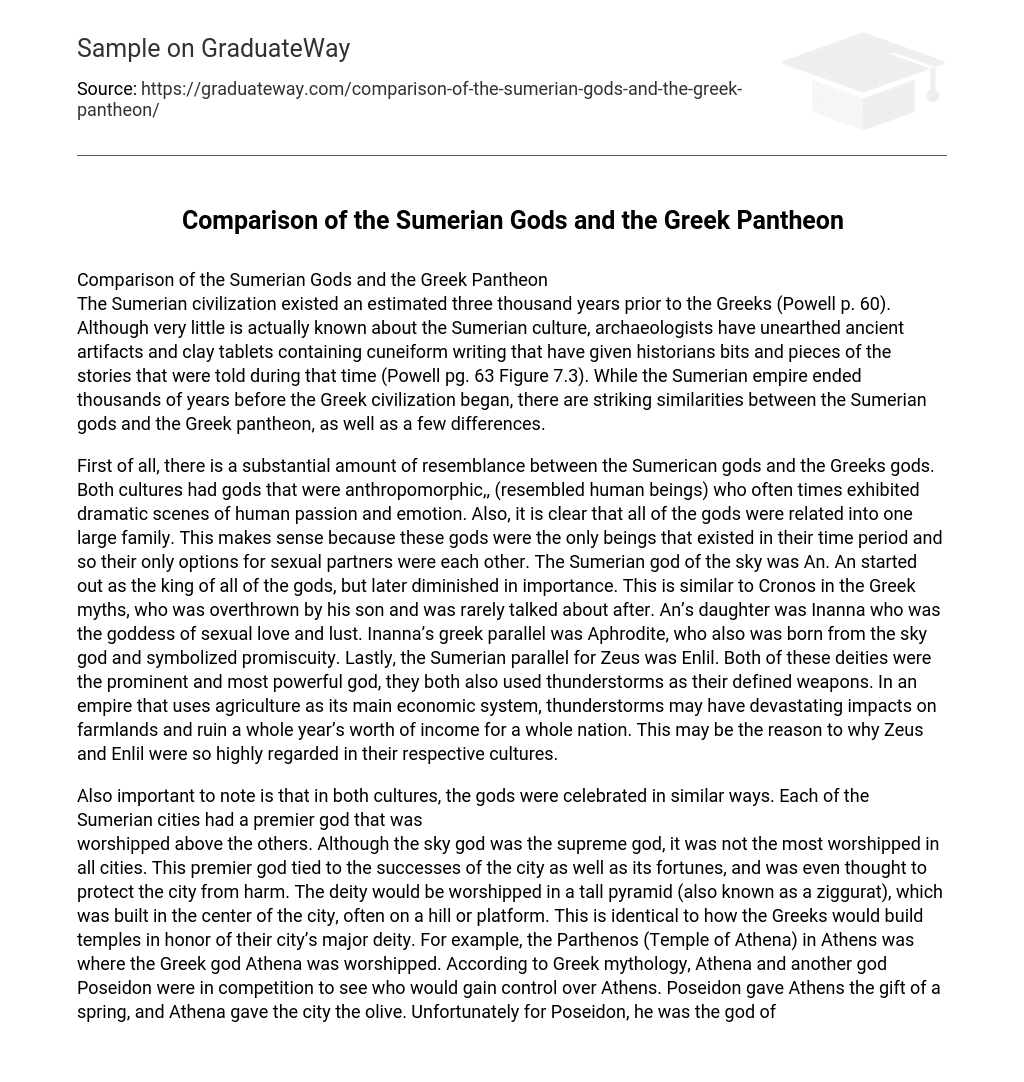The Sumerian civilization existed an estimated three thousand years prior to the Greeks (Powell p. 60). Although very little is actually known about the Sumerian culture, archaeologists have unearthed ancient artifacts and clay tablets containing cuneiform writing that have given historians bits and pieces of the stories that were told during that time (Powell pg. 63 Figure 7.3). While the Sumerian empire ended thousands of years before the Greek civilization began, there are striking similarities between the Sumerian gods and the Greek pantheon, as well as a few differences.
First of all, there is a substantial amount of resemblance between the Sumerican gods and the Greeks gods. Both cultures had gods that were anthropomorphic,, (resembled human beings) who often times exhibited dramatic scenes of human passion and emotion. Also, it is clear that all of the gods were related into one large family. This makes sense because these gods were the only beings that existed in their time period and so their only options for sexual partners were each other.
The Sumerian god of the sky was An. An started out as the king of all of the gods, but later diminished in importance. This is similar to Cronos in the Greek myths, who was overthrown by his son and was rarely talked about after. An’s daughter was Inanna who was the goddess of sexual love and lust. Inanna’s greek parallel was Aphrodite, who also was born from the sky god and symbolized promiscuity.
Lastly, the Sumerian parallel for Zeus was Enlil. Both of these deities were the prominent and most powerful god, they both also used thunderstorms as their defined weapons. In an empire that uses agriculture as its main economic system, thunderstorms may have devastating impacts on farmlands and ruin a whole year’s worth of income for a whole nation. This may be the reason to why Zeus and Enlil were so highly regarded in their respective cultures.
Also important to note is that in both cultures, the gods were celebrated in similar ways. Each of the Sumerian cities had a premier god that was worshipped above the others. Although the sky god was the supreme god, it was not the most worshipped in all cities. This premier god tied to the successes of the city as well as its fortunes, and was even thought to protect the city from harm.
The deity would be worshipped in a tall pyramid (also known as a ziggurat), which was built in the center of the city, often on a hill or platform. This is identical to how the Greeks would build temples in honor of their city’s major deity. For example, the Parthenos (Temple of Athena) in Athens was where the Greek god Athena was worshipped. According to Greek mythology, Athena and another god Poseidon were in competition to see who would gain control over Athens.
Poseidon gave Athens the gift of a spring, and Athena gave the city the olive. Unfortunately for Poseidon, he was the god of the seas and his springs were salty and not very useful for the people of Athens. However, the olive was very useful as it provided food and oil. The olive became the main export of the city, and thus Athena was heavily worshipped in Athens.
Although the stories from the two cultures were similar in many ways, there were a few noticeable differences. A big difference is the absence of a parallel for the Greek god Hades. The closest thing to the Sumerians was the goddess Ereshkigal whom was more reminiscent of Persephone than Hades. Another inequality was the Sumerian god Enki. Enki had many features that could translate him into any of the Greek gods Hephaestus, Prometheus, Poseidon, or Dionysus. Besides these slight differences though, the biggest contrast between the Sumerian gods and the Greek gods is the lack of knowledge about the Sumerian gods.
In conclusion, what is amazing is that these two cultures that existed in completely different time periods had such similar belief systems. The Sumerian gods could be matched up with Greek gods of identical characteristics, and symbols such as thunder seemed to have equal importance in both of the cultures. Although historians do not know as much as they would like to know about the Sumerians, it is discernable that there is some sort of connection between the stories from Sumer and the stories from Greece, and perhaps one day there will be a discovery that exposes that connection.
Bibliography
- Powell, Barry B. “The Development of Classical Myth.” Classical Myth. 7th ed. Boston: Pearson, 2012. 60-65. Print.





